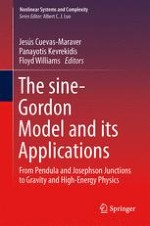The sine-Gordon model is a ubiquitous model of Mathematical Physics with a wide range of applications extending from coupled torsion pendula and Josephson junction arrays to gravitational and high-energy physics models. The purpose of this book is to present a summary of recent developments in this field, incorporating both introductory background material, but also with a strong view towards modern applications, recent experiments, developments regarding the existence, stability, dynamics and asymptotics of nonlinear waves that arise in the model. This book is of particular interest to a wide range of researchers in this field, but serves as an introductory text for young researchers and students interested in the topic. The book consists of well-selected thematic chapters on diverse mathematical and physical aspects of the equation carefully chosen and assigned.
